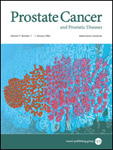
Prostate cancer: Zoledronic acid as an adjuvant therapy is well-tolerated and improves BMD

Prostate cancer: Zoledronic acid as an adjuvant therapy is well-tolerated and improves BMD
RTOG 0518: randomized phase III trial to evaluate zoledronic acid for prevention of osteoporosis and associated fractures in prostate cancer patients
Prostate Cancer Prostatic Dis. 2013 Dec;16(4):382-6. doi: 10.1038/pcan.2013.35. Epub 2013 Oct 1Did you know you're eligible to earn 0.5 CME credits for reading this report? Click Here
Synopsis
109 patients with nonmetastatic prostate cancer, undergoing androgen deprivation therapy (ADT) in combination with radiotherapy (RT), were randomized to receive a 4-mg infusion of zoledronic acid every 6 months for 3 years, as well as vitamin D and calcium supplements, or supplements alone. The purpose of this study was to examine the safety and efficacy of zoledronic acid with respect to the inci...
To view the full content, login to your account,
or start your 30-day FREE Trial today.
FREE TRIAL
LOGIN
Forgot Password?
Explore some of our unlocked ACE Reports below!

Learn about our AI Driven
High Impact Search Feature
Our AI driven High Impact metric calculates the impact an article will have by considering both the publishing journal and the content of the article itself. Built using the latest advances in natural language processing, OE High Impact predicts an article’s future number of citations better than impact factor alone.
Continue



 LOGIN
LOGIN

Join the Conversation
Please Login or Join to leave comments.